
We are celebrating 15 years — and counting — of stories that are deeply researched and deeply felt, that build a historical record of what the city has been.
We are celebrating 15 years — and counting — of stories that are deeply researched and deeply felt, that build a historical record of what the city has been.
From time to time, our Urban Omnibus columnists check in to provide commentary on issues of design, policy, and history and their impact on the life and form of the city today. Read Susanne Schindler’s previous installments here.
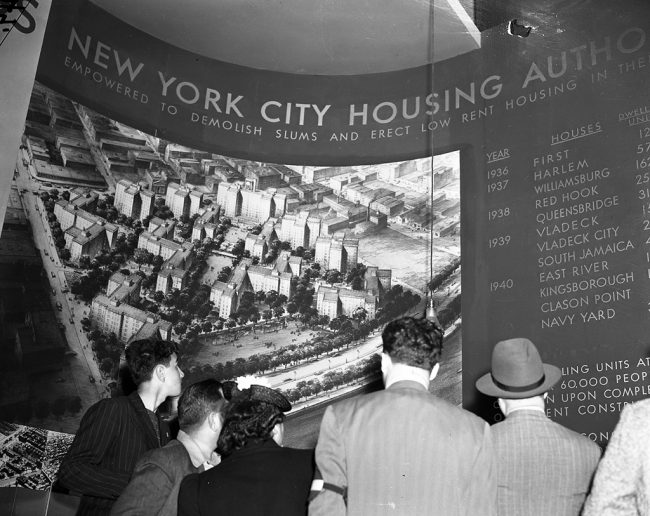
The New York City Housing Authority exhibit at the 1939-40 World’s Fair, June 8, 1940 (photographer unknown) | Photo via La Guardia and Wagner Archives, La Guardia Community College/The City University of New York, courtesy of the New York City Housing Authority
This fall, two exhibitions have waded into the contentious waters of New York City’s top policy issue of the day: the lack of affordable housing. The two should be seen in conjunction. Affordable New York: A Housing Legacy at the Museum of the City of New York is historical in scope and reflects the broader cultural perspective of independent curator Tom Mellins, co-author of New York 1880, New York 1930, and New York 1960, three invaluable tomes in a larger series on the city’s architectural history. Designing Affordability: Quicker, Smarter, More Efficient Housing Now at the AIA’s Center for Architecture emerges from consultant Marc Norman’s background in affordable housing finance and community development and focuses on architectural strategies that reduce development cost.
My expectations of both exhibitions were high. I watched them evolve[1] and have myself attempted to articulate the relationship of inequality and housing through the Buell Center’s House Housing project and exhibitions.[2] I was curious to see how each would handle the triad invariably involved in the production of housing: design, government, and the ever-elusive, but all-important finance. (Clearly, many more players have a stake in housing, including the users. In this sense, it’s even more dramatic that housing has in recent decades turned from human shelter into an object of investment and securitization — in many cases, a tax shelter.) And I was keen to see how the two sponsoring institutions would make use of a temporary installation to explain what is at stake amid these diverse players’ competing interests in a way that New York Times op-eds, HBO mini-series, or think tank reports cannot.
At the outset, the two shows refrain from tackling the Housing Question as framed by Friedrich Engels: that we will never solve the housing problem unless we change the capitalist mode of production which, by definition, creates scarcity and speculation-induced prices.[3] However, simply by using the term affordability, the exhibitions rightfully do place the disconnect between what someone makes and the cost of a roof over one’s head at the center of their investigations. I was also delighted that both exhibitions attempt to explain, through clear language and wall graphics, what exactly “affordable housing” is since it’s not an easy term to grasp. (For instance, why is governmentally assisted, income- and price-restricted housing often more expensive to produce than unregulated housing?) However, neither show addresses the underlying question of why all the different efforts aren’t adding up to ease the problem. Neither then moves beyond affirming the validity of the system of housing production we have today: a tax payer-incentivized, profit-oriented real estate market. While Mellins makes the case for the legitimacy of government intervention given the shortcomings of this system, Norman proposes that we might be able to do without government intervention if we fully tapped our architectural ingenuity.
Affordable New York is conceptually rigorous if uninventive. Mellins uses the established use of “affordable” — income-restricted, price-regulated housing — and focuses on New York City exclusively. Accordingly, the exhibition’s narrative trajectory is chronological. It aims to explain the reasons why the public sector got involved in housing in the first place and how those have evolved through four broad local phases that largely coincide with national and global shifts. “Creating a Housing Agenda, 1867–1934” reflects early private, philanthropic efforts to reform housing in the industrializing city and the advent of the New Deal. “Building Big: The New York City Housing Authority, 1934–1973” on traditional public housing and “Building Big: Beyond Public Housing, 1945–1973” on middle-class housing programs focus on the direct involvement of federal, state, and municipal government in housing development, ending with the faltering of postwar growth in the early 1970s and the pinnacle of the “urban crisis.” Finally, “Seeking New Visions: 1973–Present” takes us into the multiplicity of programs that create low- and moderate-income housing today, which generally piggyback onto market-rate housing through tax or zoning incentives.
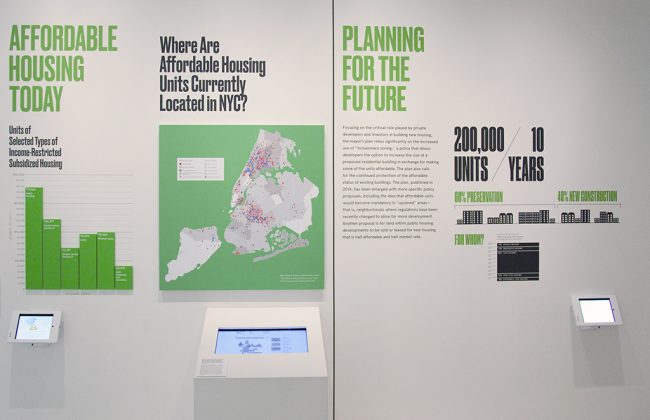
The exhibition incorporates many existing current projects that address the metrics and policies of affordable housing, including the Center for Urban Pedagogy’s “What is Affordable Housing” toolkit and the Citizens Housing and Planning Council’s “Inside the Rent” app. | Photo courtesy of MCNY
In the limited space of one room and entrance corridor (sporting a clean and restrained design by Pure & Applied), Mellins succeeds in drawing out this broad historic trajectory — not through equally broad generalizations, but with an assembly of often unexpected artifacts, an abundance of urban design models, and multimedia representations that promise to fire new synapses among MCNY’s local, tourist, and expert visitors alike.
A photograph of the New York City Housing Authority’s exhibition at the 1939-40 World’s Fair provides a reference to the central role exhibitions have played in promoting housing policies. A 1949 propaganda film with the uncanny title “For the Living” features Mayor Robert F. Wagner holding forth on the need for slum clearance and public housing. A mimeographed letter template outlines options for replacement housing meant for residents of those “slums.” A 1975 flyer — “Stop Racism in Forest Hills. Join the fight for decent housing for ALL People” — illustrates a contentious effort to integrate housing in Queens. A model of Richard Meier’s 1971 Twin Parks Northeast in the Bronx sits nearby SHoP’s Domino Sugar Factory, currently under construction in Brooklyn. And Andrew Moore’s large-format photographs bring to life “affordable housing” today. This wealth of diverse material, rounded out by interactive features like the Center for Urban Pedagogy’s digital “What is Affordable Housing” toolkit and the Citizens Housing and Planning Council’s “Inside the Rent” app, manage to convey not only why government is involved in affordable housing (because the private sector alone can’t, or won’t, provide it), but who that housing is for (a wide spectrum of individuals who otherwise wouldn’t have a place to live).
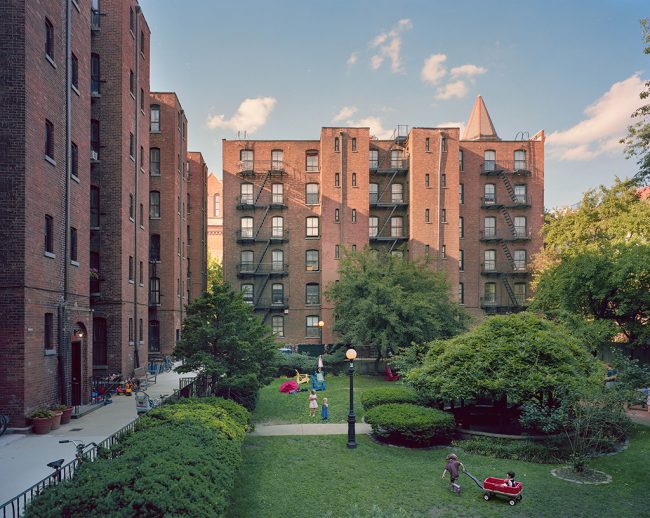
Tower Buildings Apartments (Cobble Hill Towers), Brooklyn; built 1878, Alfred Tredway White (developer), William Field and Son (architects) | Photo by Andrew Moore, 2015, courtesy of Museum of the City of New York
The show’s takeaway is clear: affordable housing policies have been an element of New York City for more than a century, have produced an enormous variety of forms, and have profoundly affected the physical and social make-up of the city. Unfortunately, it does not go one step further to address today’s fundamental concerns: while the exhibition takes the de Blasio administration’s housing plan as a point of departure, it never explains — amid its many facts and figures — the ongoing net loss of price-restricted apartments in the city. The virtuosity and multifaceted nature of the exhibition thus seems only to legitimize today’s affordable housing industry rather than even allude to its shortcomings.
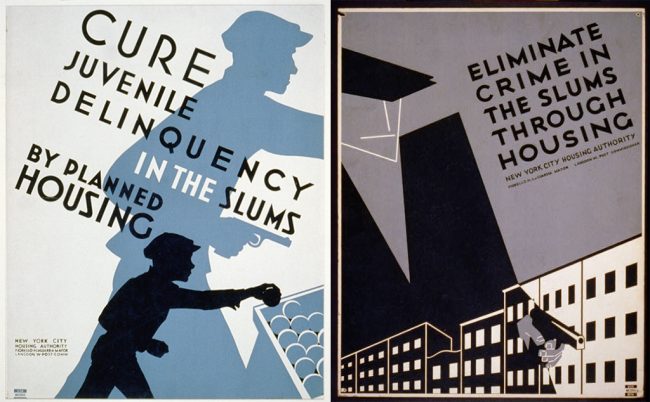
Posters by the Federal Art Project promoting planned housing, c. 1936-1938 | Images courtesy of the Library of Congress
The event and panel that opened the exhibition on September 17th hammered this home; it was a staged production for the players with a stake in this industry. As the opening act, Alicia Glen, Deputy Mayor for Housing and Economic Development, once again sang the song of exceptionalist New York — the city that was the first, is the largest, and continues to be the most committed to affordable housing. She was backed by a band that included the real-estate booster (John Banks), the developer (Ron Moelis), and the architect (Saky Yakas), all who more or less echoed Glen’s refrain. The single dissenting voice among the tenors also happened to be the only soprano: the mutual housing advocate (Ismene Speliotis) pointed to the possible negative effects of the current administration’s policies, focused on East New York, among other areas. Speliotis made clear the lack of communication between policymakers and current residents, who fear new market-rate housing — the vehicle to bring below-market housing to their neighborhood — will cause everyone’s costs to rise, irrespective of whether they might also improve services and amenities.
Downtown at Designing Affordability, the conceptual framing of what is “affordable” is deliberately looser than that uptown. The show questions the notion that affordability needs to result from governmental regulation and instead posits that affordability is “a broader concept referring to lifestyles, incomes, and how housing can be designed, constructed, and managed at a lower cost.” This argument is compelling, especially for the AIA, the commissioning institution: architects, the show proclaims, can make a dent in the exorbitant cost of housing by employing creative construction systems, perfecting layouts, and finding ingenious new ways to appropriate space.
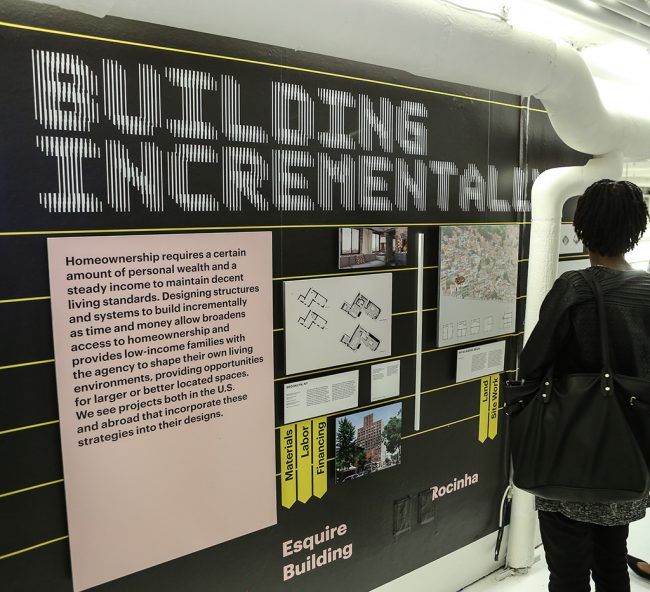
“Building Incrementally” is one of seven architectural strategies proposed by the exhibition. | Photo by Sam Lahoz
To make his case, Norman organizes 23 projects planned, completed, or theorized in the last ten years under eight architectural strategies, from “Building Incrementally” to “Constructing Modularly.” These represent a broad cross-section of US conditions, from alley flats in Houston to co-housing in Menlo Park, California, and micro-units in New York, but also expand to diverse conditions internationally — the legally unresolved status of Brazilian favelas, the highly regulated framework of French banlieues, and the hyper-density of Korean cities.
The projects are represented through fairly small wall-mounted reproductions of floor plans and photos, with wall texts that are a tad too long, and a few models on pedestals. Designers Andrew Bernheimer and Once Future succeed in tying together the Center for Architecture’s disjointed spaces, including stairwells, but the show struggles with the same constraints as all installations at the CfA: there seems little willingness or ability to break away from images on the wall. It thus contrasts with the MCNY show, where original materials in a variety of media do the talking. Only a cubic grid of aluminum tubes — suspended in the Center’s street-facing double-height space and alluding to the quantitative and spatial way in which we think of housing — gestures toward the site-specific installations that can make exhibitions more than a series of reproductions.[4]
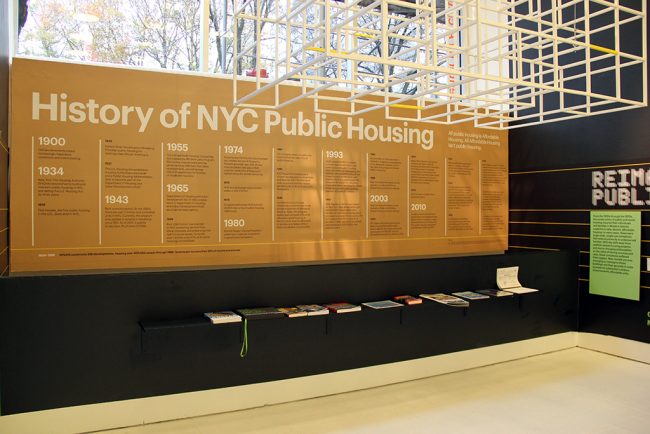
A gridded assemblage of aluminum tubes alludes to both the quantitative and spatial parameters of housing. Installation designed by Bernheimer Architecture. | Photo by Jonathan Tarleton
But my main issue with Designing Affordability is that it does not follow through on what it sets itself up to do: to explain what goes into the cost of housing in order to ask, first, what architecture has to do with it and, second, how this cost is passed on to the consumer.
The design team created a wonderful graphic feature — a yellow horizontal baseline and bar graph — that tracks through the entire show to illustrate the cost savings or increased expenditures of the featured projects in relation to the average 1,000-square-foot apartment in New York today. Development costs are broken down into Land, Site Work, Materials, Labor, Consultants, Financing, and Soft Costs; operating costs include Staffing, Insurance, Utilities, Taxes, and Operating. The translation into a seemingly simple graphic alone is a huge service to make visible and tangible issues often obscured in the discursive framework of architecture. For instance, the fact that servicing your loan is more costly than paying your architect and all other consultant fees combined should be a wake-up call as to how the decks are stacked. But some of the content is not entirely accurate: the exhibition’s assertion that materials generally constitute the largest cost while labor is only a fraction is debatable; land is often the largest or second-largest contributor to housing cost. Other content is left unexplained: where profits are located, what “Soft Costs” include. More unfortunate than these omissions is that the components of each project aren’t actually broken down into these categories. As the baseline courses through the case studies, we see only selected costs and their bars projecting either up or down — only symbolically indicating whether a particular project saved on land, labor, or utilities, to name just three. The actual project costs are never presented.
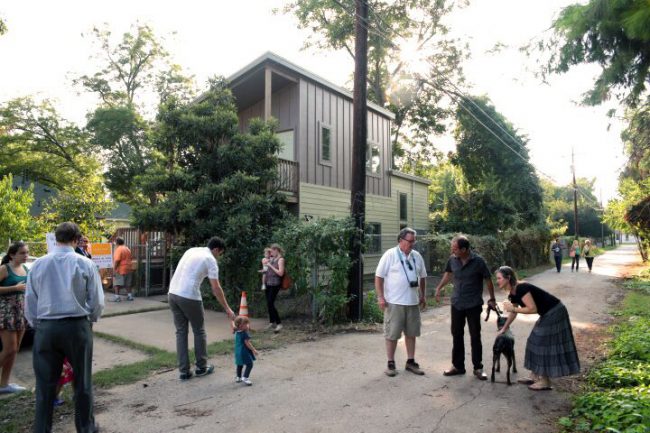
The Alley Flats Initiative, featured in the “Leveraging Land” section of Designing Affordability | Photo courtesy of Rich MacMath and the Austin Community Design and Development Center
Perhaps this exhibition’s takeaway is the difficulty of separating architectural and real estate strategies. The show never quite comes out and says what distinguishes the two. Take the category “Leveraging Land”: it features four projects, all which make use of land between buildings or unused development rights on an already built-out parcel. Norman argues that this strategy designs for affordability by “taking land costs out of the equation.” The ability to cut the market value of the land from the cost equation is not architectural, however; it’s a real estate move. In reality, the assessed market-rate value of the land was likely used to “leverage” the financing for the project. The associated architectural strategy is designing for density.
In its rhetorical focus on design, Designing Affordability not only avoids addressing questions of policy and politics, but also shortchanges the financing connected to them, something it claims to address. Under “Reimagining Public Housing,” the exhibition features Cité du Grand Parc in Bordeaux, France, a project by Lacaton & Vassal, Frédéric Druot Architecture, and Christophe Hutin. Like some of the firms’ earlier projects, they transform a high-rise social housing slab by wrapping it with a layer of enclosed porches, thereby improving living space and increasing energy efficiency. If the exhibition had asked what made this design strategy of layering or thickening possible in low-income housing in Bordeaux, and what makes it nearly impossible in US housing for the same target group, this would have been fodder enough for an entire exhibition. How much did it cost? Who is paying for it? That the example is presented under the rubric of public housing — the one form of housing development that creates dwellings beyond the reach of the market, but the one option no longer on the table politically today — should itself be food for thought.
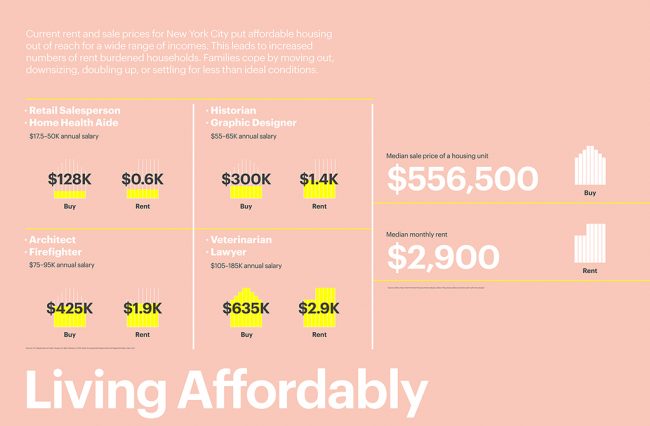
An example of the Designing Affordability wall text which seeks to break down the meaning of “affordable housing” | Image courtesy of the Center for Architecture
Do the two exhibitions reframe the Housing Question? They don’t. But they make us think about it, and they make tangible some of the human, financial, spatial, and political aspects that go into it. Some reframing may also be occurring in the numerous events organized in conjunction with the exhibitions. At Affordable New York’s opening event, it was keynote speaker Barney Frank, the long-time Congressman from Massachusetts, who moved beyond that exhibition’s exceptionalist view of New York and the CfA’s exceptionalist view of architects. Instead, he argued that if we, the assembled, care about reasonably priced housing, the only relevant thing to do is call our representatives to demand that military spending be cut; otherwise, there will never be enough money for housing. Frank is right: in a democracy, it’s about what we decide to do with our tax revenue — and about having tax revenue at all. It’s about seeing housing as beyond “affordable”: as a public good.[5] This is how the Housing Question needs to be reframed, and doing so is a task for future exhibitions.
Affordable New York is on view at the Museum of the City of New York through February 7, 2015. Designing Affordability is on view at the Center for Architecture through January 16, 2015.
Susanne Schindler is an architect and writer focused on the intersection of policy and design in housing. She has been lead researcher and co-curator of House Housing: An Untimely History of Architecture and Real Estate at Columbia University’s Temple Hoyne Buell Center for the Study of American Architecture since 2014 and is currently pursuing a PhD at ETH Zurich.
Urban Omnibus columnists are respected professionals of design, policy, history, and advocacy who provide unique and pointed perspectives on issues that face the New York metropolitan region today.
The views expressed here are those of the author only and do not reflect the position of Urban Omnibus editorial staff or The Architectural League of New York.
NOTES:
[1] I contributed three essays to what was intended to be the catalog of the MCNY show, originally curated by historian and NJIT professor Nicholas Bloom. When Tom Mellins took over, the publication became Affordable Housing in New York: The People, Places, and Policies That Transformed a City, co-edited with Matthew Lasner and released this month by Princeton University Press. I was on the advisory board of the CfA show, which met twice over the course of a year to provide feedback on the evolving concept to the curatorial team.
[2] Since mid-2013, I have been lead researcher and co-curator, with director Reinhold Martin and program coordinator Jacob Moore, of the project House Housing: An Untimely History of Architecture and Real Estate at Columbia University’s Temple Hoyne Buell Center for the Study of American Architecture, which has resulted in a series of exhibitions shown to date in Venice, Chicago, and Berlin; the publication The Art of Inequality: Architecture, Real Estate, and Housing—A Provisional Report; and a website making all of the materials accessible: house-housing.com.
[3] Friedrich Engels’ The Housing Question was first published as a series of newspaper articles in 1872-3 and has been translated and republished many times since. The living situation of workers in industrializing cities was not unlike today’s post-industrial urbanization: speculation and exploitation due to scarcity of housing ran rampant from Paris to London. Engels argued that if the system of production is not changed, the inequality perpetuated through housing would never be solved. Reading Engels today is astounding given that his descriptions of Haussmannian Paris read like a description of contemporary Downtown Brooklyn. Engels’ text is also the namesake of an ambitious exhibition and program on view this fall at the House of World Cultures in Berlin, of which House Housing is a part.
[4]The power of full-scale models is something two other current exhibitions on architecture and housing understand. The first Chicago Architecture Biennial makes ample use of full-scale models to get at issues pertaining to housing and how we live, some commissioned and developed expressly for the exhibition, such as House No. 11 (Corridor House) by MOS. Berlin’s Wohnungsfrage exhibition, mentioned in footnote two, was centered around four full-scale housing models developed over the course of a year by international architecture studios in response to and in collaboration with local activists.
[5]I am borrowing the notion of “public good” in relation to housing from a program recently launched by the National Public Housing Museum and its associate director and curator Todd Palmer, in partnership with the University of Illinois at Chicago’s Great Cities Initiative.
The views expressed here are those of the authors only and do not reflect the position of The Architectural League of New York.